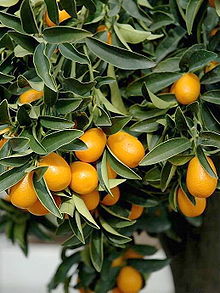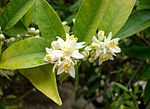- Citrus japonica 'Margarita'
-
Citrus japonica 'Margarita' 
Scientific classification Kingdom: Plantae (unranked): Angiosperms (unranked): Eudicots (unranked): Rosids Order: Sapindales Family: Rutaceae Genus: Citrus Species: C. margarita Binomial name Citrus japonica 'Margarita' Synonyms Fortunella japonica
Citrus japonica 'Margarita', or Fortunella japonica, is a species of kumquat, also known as Oval Kumquat or Nagami Kumquat, and one of the three main cultivars.[1] In 1846, Robert Fortune brought back this species of kumquat, as well as two others, from an expedition to China for the Royal Horticultural Society.[2] This species lives only in climates with hot summers, with temperatures ranging from 25 to 30 °C (77 to 86 °F). However, it is remarkably tolerant of frost, sometimes withstanding temperatures as low as −8 °C (18 °F).
Contents
History
The Oval Kumquat is native to southern China.[3][4] Robert Fortune (after whom the genus Fortunella was named) brought it to London in 1846.[5] Fortunella margarita is the most common species of Kumquat in the United States since Glen St. Mary and Royal Palm nurseries introduced it from Japan into Florida in 1885. It has been grown for profit since 1895, most prolifically in Saint Joseph, known as the "Kumquat Capitol".[6]
Carl Peter Thunberg originally classified the kumquats as members of the citrus genus in 1784 in his book Flora Japonica. They were moved to a new genus, Fortunella, in 1915 by Walter T. Swingle in honor of Robert Fortune. In accordance with the 1994 Tokyo Code of the International Code of Botanical Nomenclature, the genus name reverted to Citrus.[7][8][9]
Description
The Nagami is a small evergreen tree. The plant has small, strongly perfumed flowers that appear in late spring. In early autumn, the plant bears small, bright orange fruits which can be consumed. The fruits are ovular in shape (hence the alternate name Oval Kumquat), and may be between 1 to 2 centimetres (0.39 to 0.79 in) long. These fruits have an edible, sweet rind and a sour acidic pulp. The pulp is divided into four or five segments and contains two to three seeds.[5]
The plant itself is slow-growing and reaches a height of approximately 2.5 to 4.5 metres (8.2 to 15 ft).[10] The leaves are deep green and small, and usually grow no longer than 7 centimetres (2.8 in) and no wider than 3.5 centimetres (1.4 in).[11] In appearance, the tree somewhat resembles an orange tree.
Because of similarities in appearance, Citrus japonica 'Margarita' is sometimes confused with Citrus japonica 'Japonica'.
Uses
Food
The Oval Kumquat's oblong, brightly-coloured fruits are often consumed by humans, and have been described as "...zesty flesh in a sleeve of skin that tastes like lavender crossed with citrus".[12] The fruit is citrus and tart in taste, and may be made into marmalade or preserves.
Cultivation
Citrus japonica 'Margarita', often named as Fortunella margarita 'Nagami,' is cultivated as an ornamental plant for planting in gardens, and in garden pots and container gardens on patios and terraces. The symmetrical leaves and fruiting season in winter are additional aesthetic features. It is also grown as a houseplant and in conservatories.
See also
- Citrus hybrids
- ×Citrofortunella microcarpa (Calamondin)
- ×Citrofortunella mitis (Musk Lime)
- Citrus × depressa (Shikwasa, Hirami lemon)
References
- ^ "KUMQUAT". Edible: An Illustrated Guide to the World's Food Plants. National Geographic. Lane Cove, New South Wales: Global Book Publishing. 2008. pp. 70. ISBN 9781426203725. http://books.google.com/books?id=HORIzBx17DYC&pg=PA70&dq=Nagami+Kumquat&client=safari#v=onepage&q=Nagami%20Kumquat&f=false. Retrieved 17 November 2009.
- ^ "Fortunella margarita. KUMQUAT. China". Encyclopedia of Stanford Trees, Shrubs, and Vines. Trees.Stanford.edu. http://trees.stanford.edu/ENCYC/FORmar.htm. Retrieved 2009-11-18.
- ^ "oval kumquat." Encyclopædia Britannica. 2009. Encyclopædia Britannica Online. 17 Nov. 2009 <http://www.britannica.com/EBchecked/topic/435749/oval-kumquat>.
- ^ Kumquats at Floridata
- ^ a b Morton, Julia F. (1987). "Kumquat". Fruits of warm climates. Miami Fl.. pp. 182–185. http://www.hort.purdue.edu/newcrop/morton/kumquat.html. Retrieved 2009-11-18.
- ^ Nagami at Kumquatgrowers.com
- ^ International Code of Botanical Nomenclature(Tokyo Code) 1994 Ch. II, Sec. III Article 11.3 "For any taxon from family to genus inclusive, the correct name is the earliest legitimate one with the same rank"
- ^ Nicolosi et al. (Theor. Appl. Genetics 100: 1155–1166. 2000)
- ^ Mabberley (Blumea 49: 481–498. 2004)
- ^ Nagami Kumquat on GrowQuest.com (gardening website)
- ^ Fortunella margarita at Cool exotics.com
- ^ Petersen, Pete (3 February 2009). "Nagami kumquat adds burst of bright flavor". The Oregonian. http://www.oregonlive.com/foodday/index.ssf/2009/02/nagami_kumquat_adds_burst_of_b.html. Retrieved 2009-11-18.
Categories:- Citrus
- Flora of China
- Fruits originating in Asia
- Garden plants of Asia
- Ornamental trees
Wikimedia Foundation. 2010.

